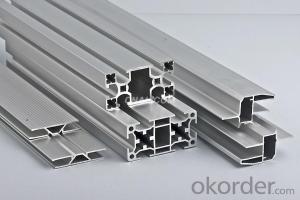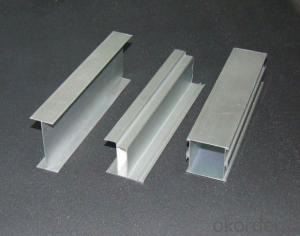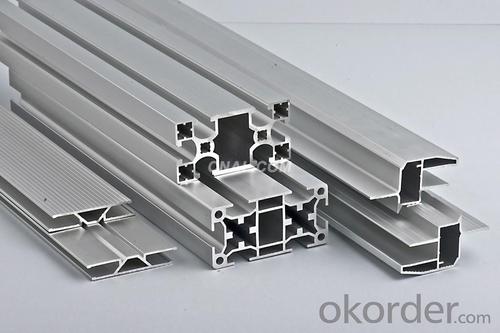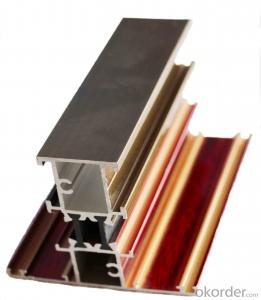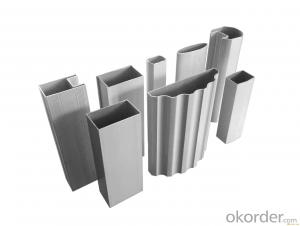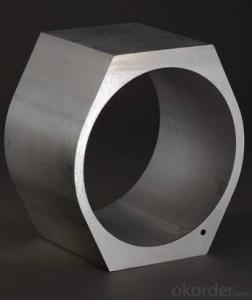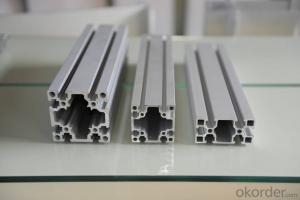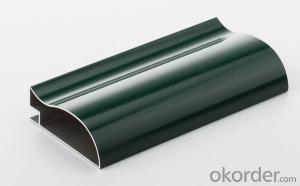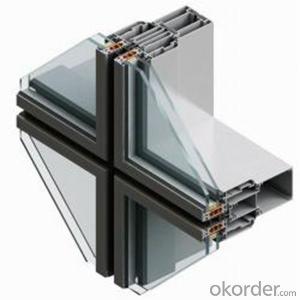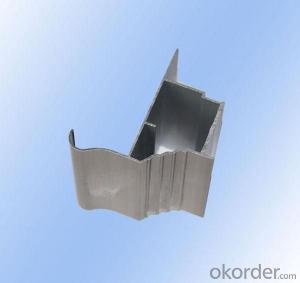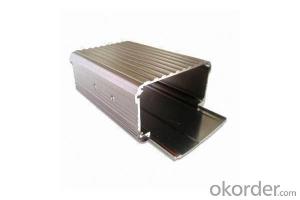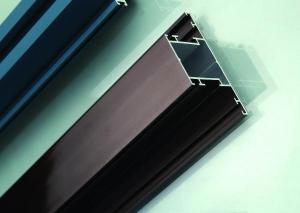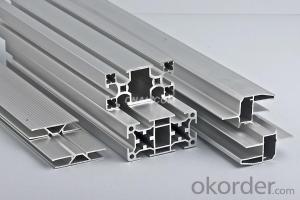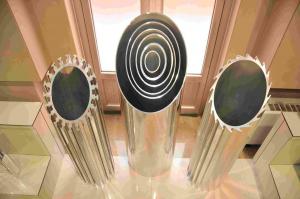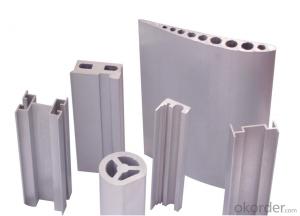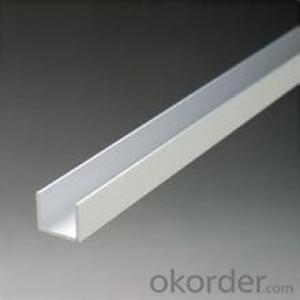Anodized Aluminum Profiles - Mill Finished Aluminum Profile in China All Alloy Series
- Loading Port:
- Shanghai
- Payment Terms:
- TT OR LC
- Min Order Qty:
- 1000 m.t.
- Supply Capability:
- 10000 m.t./month
OKorder Service Pledge
OKorder Financial Service
You Might Also Like
Specification
Aluminium is a relatively soft, durable, lightweight, ductile and malleable metal with appearance ranging from silvery to dull gray, depending on the surface roughness. It is nonmagnetic and does not easily ignite. A fresh film of aluminium serves as a good reflector (approximately 92%) of visible light and an excellent reflector (as much as 98%) of medium and far infrared radiation. The yield strength of pure aluminium is 7–11 MPa, while aluminium alloys have yield strengths ranging from 200 MPa to 600 MPa. Aluminium has about one-third the density and stiffness of steel. It is easily machined, cast, drawn and extruded.
Aluminium alloys (or aluminum alloys; see spelling differences) are alloys in which aluminium (Al) is the predominant metal. The typical alloying elements are copper, magnesium, manganese, silicon, tin and zinc. There are two principal classifications, namely casting alloys and wrought alloys, both of which are further subdivided into the categories heat-treatable and non-heat-treatable.
Material | Alloy 6063,6061,6005or according to customer’s choice |
Temper | T3, T4, T5, T6 |
Surface | Anodize, electrophoresis, powder coating, PVDF coating, wood grain painting, matted, etc. |
Length | Coating 6.5 meters, Anodizing 6.5 meters, Mill finish 5-6 meters |
Application | Industrial, electrical equipment(TV set, air conditioner, refrigerator, computer), decoration,construction, transportation |
Custom Made | We can package following with customer's request. |
Products are exported to United States, Canada, U.A.E, Brazil, Mexico,Thailand, Vietnam, Nigeria etc, over 100 countries and regions all over the world.
1. Application of Mill Finished Aluminum Profile in China all Alloy Series
(1).Interior: wall cladding, ceilings, bathrooms, kitchens and balconies, shutters, doors...
(2).Exterior: wall cladding, facades, roofing, canopies, tunnels,column covers , renovations...
(3).Advertisement: display platforms, signboards, fascia, shop fronts...
2. Feature of Mill Finished Aluminum Profile in China all Alloy Series
Surfact Quality :
Be free from Oil Stain, Dent, Inclusion, Scratches, Stain, Oxide Dicoloration, Breaks, Corrosion, Roll Marks, Dirt Streaks and other defect which will interfere with use,
Mechenical Property:
Chemical Composite and Mechanical Property
3. Certificate:
SGS and ROHS(if client request, paid by client), MTC(plant provided), Certificate of Origin(FORM A, FORM E, CO), Bureau Veritas and SGS (if client request, paid by client), CIQS certificate
4. Image of Mill Finished Aluminum Profile in China all Alloy Series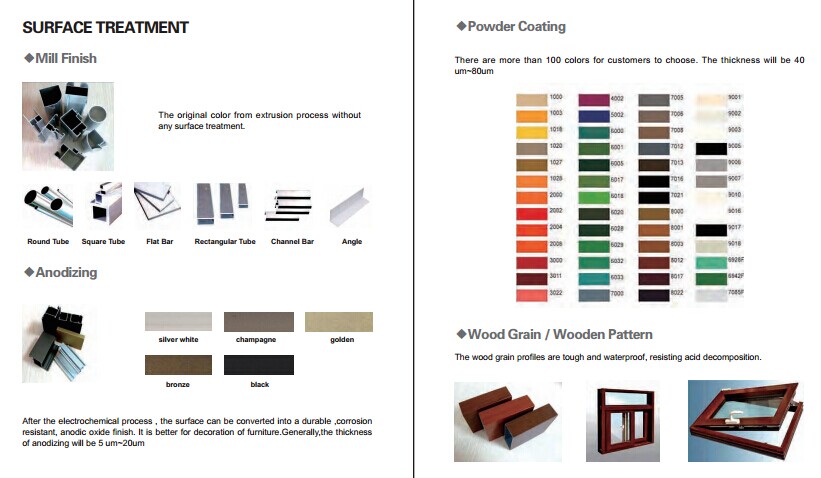
5. Package and shipping of Mill Finished Aluminum Profile in China all Alloy Series
First, plastic cloth with drying agent inside; Second, Pearl Wool ; Third, wooden cases with dry agent , fumigation wooden pallets, aluminum surface could cover blue PVC film
6. FAQ
1) What is the delivery time?
Dpends on actual order, around 20 to 35 days
2)What is the QC system:
We have QC staff of 20 persons and advanced equipment, each production is with MTC traced from Aluminum ingot lot.
3) What market do you mainly sell to?
Australia, America, Asia, Middle East, Western Europe, Africa etc
- Q: This question asks if aluminum profiles are suitable for both exterior and interior uses.
- <p>Yes, aluminum profiles can be used for both exterior and interior applications. They are popular for exterior use due to their resistance to weather and corrosion, making them ideal for construction and architectural projects. For interior applications, aluminum profiles are valued for their strength, lightweight, and aesthetic appeal, often used in furniture, window frames, and decorative elements. Their versatility and durability make them a preferred choice in various settings.</p>
- Q: Is it possible to recycle aluminum profiles repeatedly without a substantial loss in their quality or functionality?
- <p>Yes, aluminum profiles can be recycled multiple times without significant degradation in performance. Aluminum is highly recyclable, and the recycling process does not compromise its properties. In fact, recycled aluminum maintains the same strength, durability, and malleability as new aluminum. This makes it an environmentally friendly material, as it reduces the need for mining new aluminum and conserves resources.</p>
- Q: Are aluminum profiles suitable for high-temperature environments?
- Aluminum profiles are generally unsuitable for environments with high temperatures. Despite its excellent thermal conductivity and lightweight nature, aluminum has a lower melting point compared to other metals. At temperatures exceeding 400°C (752°F), aluminum begins to soften and can eventually lose its structural integrity. In high-temperature surroundings, aluminum profiles can experience deformation, distortion, or even complete failure. This can jeopardize the stability and functionality of any structure or system relying on aluminum profiles. Nevertheless, there exist specific aluminum alloys that are specifically engineered to withstand higher temperatures. Alloys like 6061 and 7075 have enhanced heat resistance and can endure higher temperatures without significant damage. These specialized alloys are commonly employed in applications requiring resistance to elevated temperatures, such as aerospace components or certain industrial processes. However, it is essential to thoroughly evaluate the temperature requirements of a given environment before utilizing aluminum profiles. In extremely high-temperature settings, alternative materials like steel or refractory metals may be more appropriate due to their higher melting points and superior heat resistance properties.
- Q: What are the differences between standard and non - standard shapes?
- Hello, not within the scope of the national standard, so it is called non-standard,The standard piece is within the national standardThat's the difference,This GB standard can be found, are unified
- Q: This question asks if aluminum profiles can be used in cold weather conditions and if they maintain their properties in such environments.
- <p>Yes, aluminum profiles are suitable for use in cold climates. Aluminum is a durable material with excellent resistance to corrosion and weathering, which includes maintaining its integrity in low temperatures. It does not rust or degrade significantly in cold conditions, making it a reliable choice for construction and other applications in cold climates. However, it's important to consider the specific alloy and any protective coatings or treatments that may be necessary to ensure optimal performance in extreme cold.</p>
- Q: Can aluminum profiles be used for creating lighting fixtures?
- Yes, aluminum profiles can be used for creating lighting fixtures. Aluminum is a versatile material that is lightweight, durable, and has excellent thermal conductivity, making it suitable for dissipating heat generated by lighting components. Additionally, aluminum profiles can be easily shaped, allowing for various designs and forms of lighting fixtures.
- Q: What are the different surface engraving or etching techniques for aluminum profiles?
- There are several surface engraving or etching techniques available for aluminum profiles, each offering unique benefits and results. Some of the commonly used techniques include: 1. Chemical Etching: This process involves the use of chemicals to selectively remove the top layer of the aluminum profile. It allows for precise and intricate designs to be etched onto the surface, making it suitable for decorative purposes. 2. Laser Engraving: Laser engraving utilizes a high-powered laser beam to vaporize the aluminum surface, creating a permanent etching. This technique offers excellent precision, allowing for detailed designs and logos to be engraved onto the profile. 3. Mechanical Engraving: Mechanical engraving involves the use of rotary cutters or diamond-tipped tools to physically engrave the surface of the aluminum profile. This technique is commonly used for industrial applications, such as marking product codes or serial numbers. 4. Electrochemical Etching: This technique uses an electric current and an electrolyte solution to etch the aluminum surface. It is commonly employed for creating durable and legible markings, such as product labels or identification codes. 5. Sandblasting: Sandblasting involves directing a stream of abrasive particles at high speed onto the aluminum surface. This process removes the top layer of the material, leaving a textured or frosted appearance. Sandblasting is often used for decorative purposes or to create a matte finish. 6. Acid Etching: Acid etching utilizes an acid solution to selectively remove the top layer of the aluminum surface. This technique is commonly used for creating a matte or satin finish, as well as for creating patterns or textures on the profile. These engraving and etching techniques offer a wide range of options for aluminum profiles, allowing for customization, branding, or functional purposes. The choice of technique depends on factors such as the desired design, level of detail, durability requirements, and the intended application of the aluminum profile.
- Q: Are aluminum profiles compatible with other materials for construction purposes?
- <p>Yes, aluminum profiles can be used in combination with other materials in construction. They are often paired with steel, glass, and various plastics due to their lightweight, durability, and corrosion resistance. Aluminum's ability to be easily joined and its compatibility with different finishes make it a versatile choice for construction projects.</p>
- Q: I have a disinfection cabinet to cut off a piece of aluminum to install the control board, how to cut? What tool to cut?
- The use of wire saw can be sawed, if you cannot use a wire saw, it can only be used to drill holes along the need the position of the drill hole, finally use a tool to trim it to the edge.
- Q: What are the different packaging and shipping considerations for aluminum profiles?
- Some different packaging and shipping considerations for aluminum profiles include ensuring proper protection against scratches and dents during transportation, using suitable packaging materials such as foam or bubble wrap, securing the profiles to prevent movement or shifting, labeling packages with handling instructions, and selecting appropriate shipping methods to minimize the risk of damage.
Send your message to us
Anodized Aluminum Profiles - Mill Finished Aluminum Profile in China All Alloy Series
- Loading Port:
- Shanghai
- Payment Terms:
- TT OR LC
- Min Order Qty:
- 1000 m.t.
- Supply Capability:
- 10000 m.t./month
OKorder Service Pledge
OKorder Financial Service
Similar products
Hot products
Hot Searches
Related keywords
